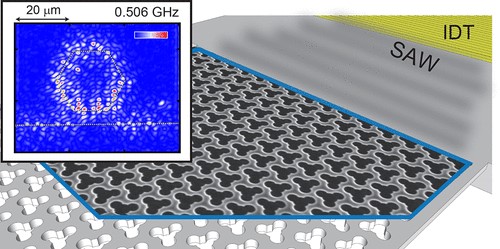
| Phononic crystals and waveguides |
| Recent Activities |
|
Valley Pseudospin Polarized Evanescent Coupling between Microwave Ring Resonator and Waveguide in Phononic Topological Insulators D. Hatanaka, H. Takeshita, M. Kataoka, H. Okamoto, K. Tsuruta, and H. Yamaguchi, Nano Lett. 24, 18, 5570 (2024) |
 |
A coupled ring-waveguide structure is at the core of bosonic wave-based information processing systems, enabling advanced wave manipulations such as filtering, routing, and multiplexing. However, its miniaturization is challenging due to momentum conservation issues in rings with larger curvature that induce significant backscattering and radiation leakage and hampering stable operation. Here, we address it by taking an alternative approach of using topological technology in wavelength-scale and microwave ring-waveguide coupled systems built in nanoengineered phononic crystals. Our approach, which leverages pseudospin conservation in valley topological systems, eliminates phonon backscattering and achieves directional evanescent coupling. The resultant hypersonic waves in the tiny ring exhibit robust transport and resonant circulation. Furthermore, the ring-waveguide hybridization enables critical coupling, where valley-dependent ring-waveguide interference blocks the transmission. Our findings reveal the capability of topological phenomena for managing ultrahigh-frequency phonons in nano/microscale structures and pave the way for advanced phononic circuits in classical and quantum signal processing applications. |
|
Buckling-induced quadratic nonlinearity in silicon phonon waveguide structures M. Kurosu, D. Hatanaka, H. Okamoto and H. Yamaguchi, Jpn. J. Appl. Phys. 61, SD1025 (2022). |
| We fabricated and characterized a single-crystal silicon phonon waveguide structure with lead zirconate titanate (PZT) piezoelectric transducers. The compressive stress in a silicon-on-insulator wafer causes a membrane waveguide to buckle, leading to the quadratic nonlinearity. The PZT transducer integrated in an on-chip configuration enables us to excite high-intensity mechanical vibration, which allows the characterization of nonlinear behavior. We observed a softening nonlinear response as a function of the drive power and demonstrated the mode shift and frequency conversion. This is the first report of the nonlinear behavior caused by the quadratic nonlinearity in a buckled phonon waveguide structure. This study provides a method to control the sign and the order of nonlinearity in a phonon waveguide by utilizing the internal stress, which allows the precise manipulation of elastic waves in phononic integrated circuits. | 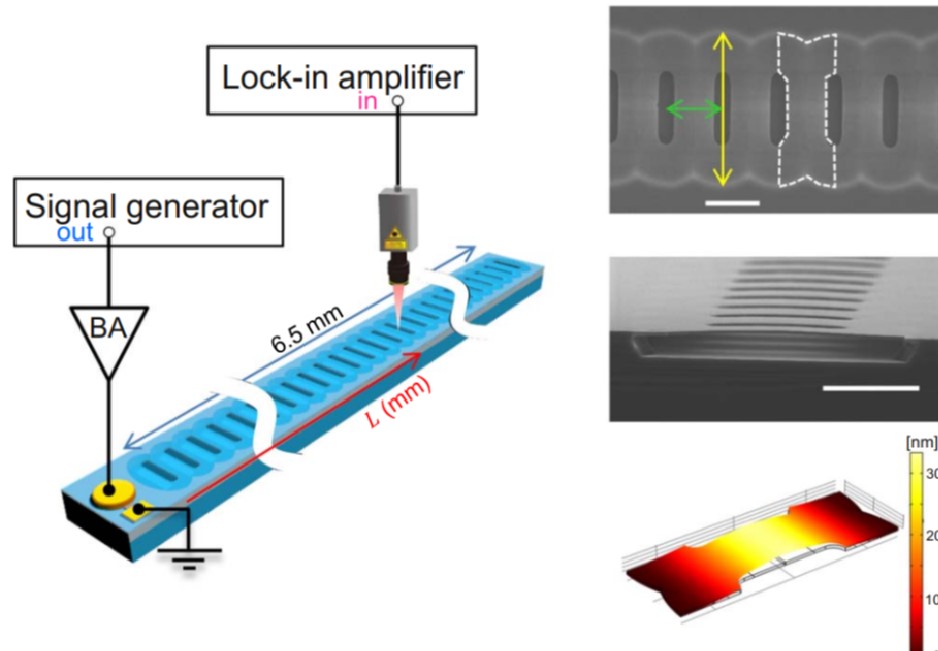 |
|
Real-Space Characterization of Cavity-Coupled Waveguide Systems in Hypersonic Phononic Crystals D. Hatanaka and H. Yamaguchi, Phys. Rev. Applied 13, 024005 (2020) |
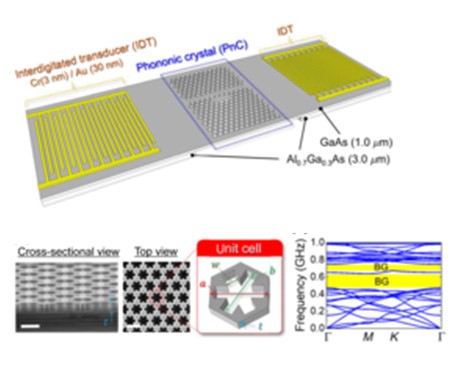 |
A phononic crystal formed in a suspended membrane provides full confinement of hypersonic waves and thus realizes a range of chip-scale manipulations. In this paper, we demonstrate mode-resolved real-space characterization of mechanical-vibration properties in cavities and waveguide systems. Multiple resonant modes in various designed cavities are independently characterized, and wavelength-scale high-Q resonances up to Q=4200 under atmospheric conditions are confirmed. This also reveals that the waveguide allows us to observe mode-resolved wave transmission and thereby drive evanescently coupled cavities. The methods offer a significant tool with which to build compact and low-power microwave phononic circuitry for applications to signal processing and hybrid quantum systems. |
|
Mechanical Kerr Nonlinearity of Wave Propagation in an On-Chip Nanoelectromechanical Waveguide
M. Kurosu, D. Hatanaka, and H. Yamaguchi, Phys. Rev. Applied 13, 014056 (2020) |
| We experimentally and numerically demonstrate nonlinear flexural wave propagation using an on-chip nanoelectromechanical waveguide. More specifically, third-order nonlinear phenomena of self-phase modulation, cross-phase modulation, and four-wave mixing caused by the mechanical Kerr effect are realized. Our experimental observations are correctly described by the nonlinear Schrodinger equation. The nanomechanical and integratable platform enables on-chip manipulation of mechanical wave propagation, thus offering the potential to develop novel functional devices and study nonlinear mechanical phenomena. | 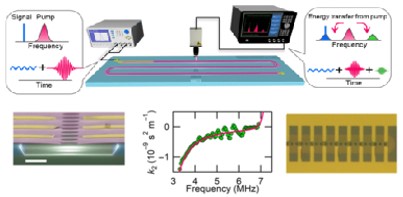 |
|
On-chip temporal focusing of elastic waves in a phononic crystal waveguide
M. Kurosu, D. Hatanaka, K. Onomitsu and H. Yamaguchi, Nat. Commun. 9, 1331 (2018) |
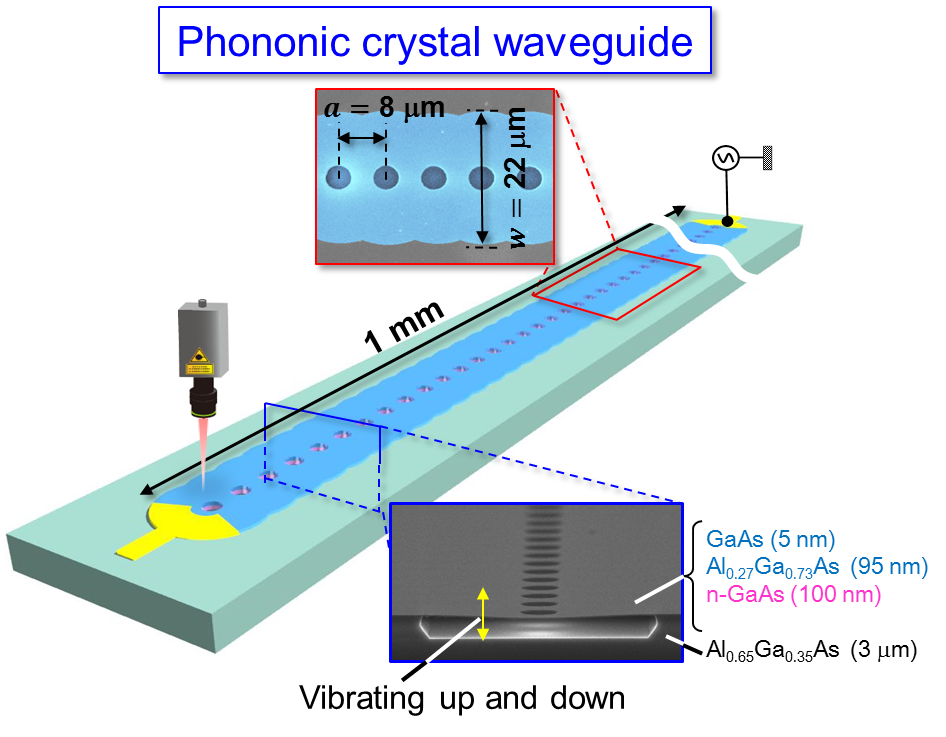 |
The ability to manipulate acoustic and elastic waveforms in continuous media has attracted significant research interest and is crucial for practical applications ranging from biological imaging to material characterization. Although several spatial focusing techniques have been developed, these systems require sophisticated resonant structures with narrow bandwidth, which limit their practical applications. Here we demonstrate temporal pulse manipulation in a dispersive one-dimensional phononic crystal waveguide, which enables the temporal control of ultrasonic wave propagation. On-chip pulse focusing is realized at a desired time and position with chirped input pulses that agree perfectly with the theoretical prediction. Moreover, traveling four-wave mixing experiments are implemented, providing a platform on which to realize novel nonlinear phenomena in the system. Incorporating this dispersive pulse engineering scheme into nonlinear phononic crystal architecture opens up the possibility of investigating novel phenomena such as phononic solitons. |
|
Phonon propagation dynamics in band-engineered one-dimensional phononic crystal waveguides
D. Hatanaka, A. Dodel, I. Mahboob, K. Onomitsu, and H. Yamaguchi, New J. Phys. 17 113032 (2015) |
| The phonon propagation dynamics in a phononic crystal waveguide, realized via a suspended one-dimensional membrane array with periodic air holes, is investigated as function of its geometry. The bandstructure of the phononic crystal waveguide can be engineered by modifying the characteristics of the phonon waves by varying the waveguide width and the pitch of the air holes. This enables the phonon transmission bands, the bandgaps, the velocity and the nonlinear dispersion in the phononic crystal to be controlled. Indeed the engineered bandstructure can even be tuned to sustain multiple phonon modes in a given branch which while being spectrally degenerate can be temporally resolved via their differing group velocities. Furthermore, the ability to tune the bandstructure and thus the nonlinear dispersion can be harnessed to efficiently activate nonlinear phenomena such as mechanical four wave mixing. This systematic study reveals the key geometric parameters that enable the phonon transport in phononic crystal waveguides to be fully controlled. | 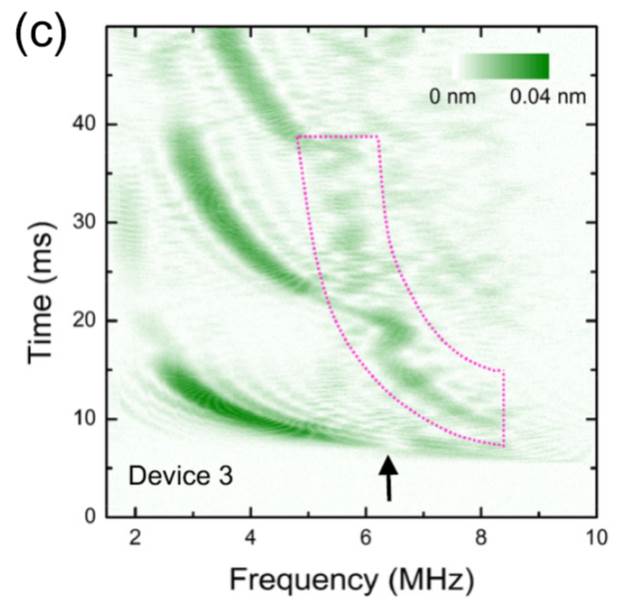 |
|
Mechanical random access memory in a phonon circuit Daiki Hatanaka, Imran Mahboob, Koji Onomitsu, and Hiroshi Yamaguchi, Applied Physics Express 7, 125201 (2014) |
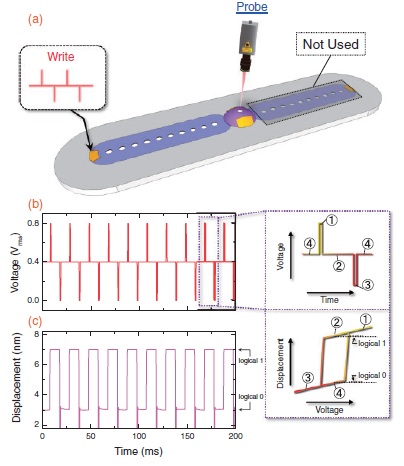 |
The phonon propagation dynamics in a phononic crystal waveguide, realized via a suspended one-dimensional membrane array with periodic air holes, is investigated as function of its geometry. The bandstructure of the phononic crystal waveguide can be engineered by modifying the characteristics of the phonon waves by varying the waveguide width and the pitch of the air holes. This enables the phonon transmission bands, the bandgaps, the velocity and the nonlinear dispersion in the phononic crystal to be controlled. Indeed the engineered bandstructure can even be tuned to sustain multiple phonon modes in a given branch which while being spectrally degenerate can be temporally resolved via their differing group velocities. Furthermore, the ability to tune the bandstructure and thus the nonlinear dispersion can be harnessed to efficiently activate nonlinear phenomena such as mechanical four wave mixing. This systematic study reveals the key geometric parameters that enable the phonon transport in phononic crystal waveguides to be fully controlled. |
|
Phonon waveguides for electromechanical circuits
D. Hatanaka, I. Mahboob, K. Onomitsu and H. Yamaguchi , Nature Nanotech. 9, 520 (2014) @ |
| Nanoelectromechanical systems (NEMS), utilizing localized mechanical vibrations, have found application in sensors, signal processors and in the study of macroscopic quantum mechanics. The integration of multiple mechanical elements via electrical or optical means remains a challenge in the realization of NEMS circuits. Here, we develop a phonon waveguide using a one-dimensional array of suspended membranes that offers purely mechanical means to integrate isolated NEMS resonators. We demonstrate that the phonon waveguide can support and guide mechanical vibrations and that the periodic membrane arrangement also creates a phonon bandgap that enables control of the phonon propagation velocity. Furthermore, embedding a phonon cavity into the phonon waveguide allows mobile mechanical vibrations to be dynamically switched or transferred from the waveguide to the cavity, thereby illustrating the viability of waveguide resonator coupling. These highly functional traits of the phonon waveguide architecture exhibit all the components necessary to permit the realization of all-phononic NEMS circuits. | 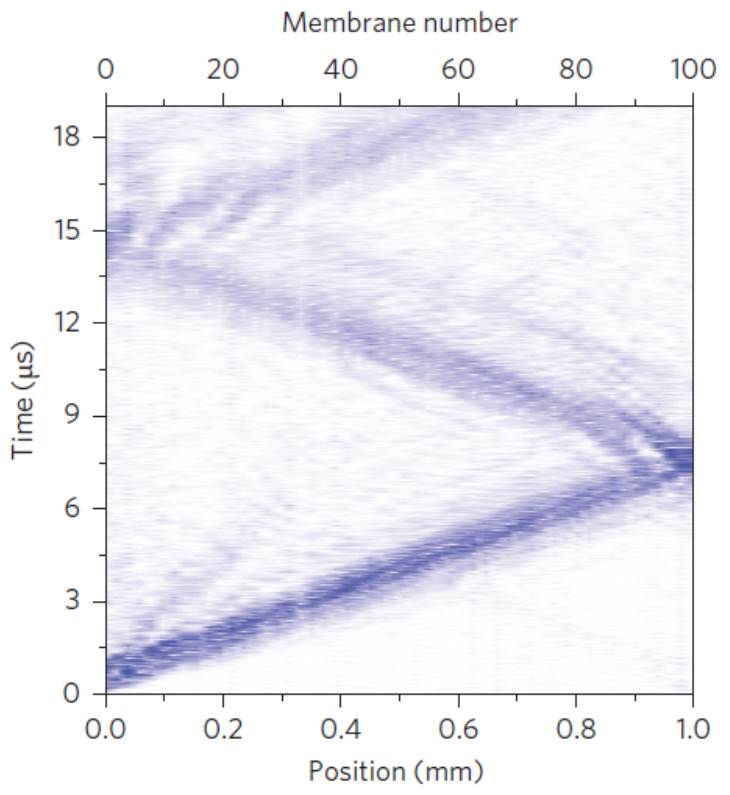 |
|
A phonon transistor in an electromechanical resonator array
D. Hatanaka, I. Mahboob, K. Onomitsu, and H. Yamaguchi , Appl. Phys. Lett. 102, 213102 (2013) @ |
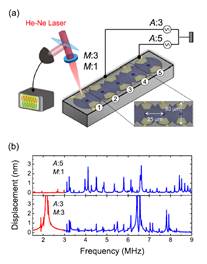 |
An electromechanical resonator array is developed that consists of 5 mechanically coupled membranes. Mechanical excitation of the array results in 2 types of oscillations, an extended mechanical oscillation that propagates through all 5 membranes and a localized mechanical oscillation that is confined to just some of the membranes. The dynamic interaction of these 2 types of oscillations is used to implement a transistor in this phononic system. |
|
An electromechanical membrane resonators
D. Hatanaka, I. Mahboob, H. Okamoto, K. Onomitsu and H. Yamaguchi , Appl. Phys. Lett. 101, 063102 (2012) @ |
| An electrically active membrane-based mechanical resonator was fabricated from a GaAs/AlGaAs heterostructure. The mechanical motion of the membrane was piezoelectrically excited and detected. The piezoelectric transducer could also excite a range of resonance modes in the membrane that were identified and mapped via optical interferometry. Furthermore, the various mode shapes combined with the piezoelectric transduction could be used to execute mechanical-logic-gates. The development of an electrically active membrane-based mechanical resonator paves the way towards responsive electromechanical detectors and highly functional opto-electro-mechanical systems. | 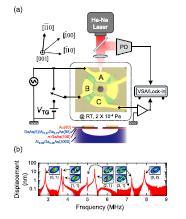 |